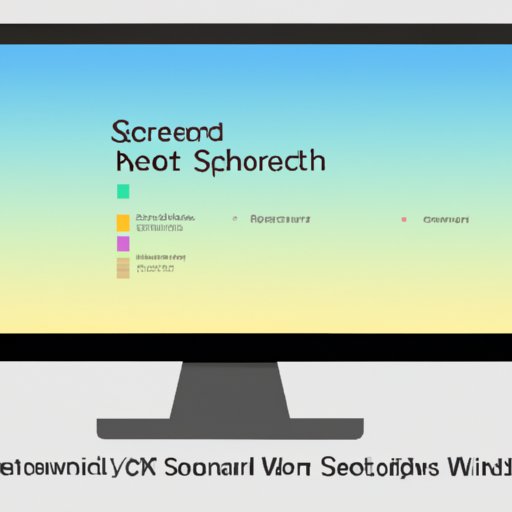I. Introduction
Capturing screenshots on a PC is an essential task for many individuals, from students and teachers to designers and bloggers. Whether you want to capture an image for a presentation or create a tutorial, knowing how to screenshot on a PC is an essential skill. In this article, we will provide a step-by-step guide to help you take screenshots using Windows tools, third-party software options, and offer top tips and troubleshooting solutions. This informative piece is aimed at all PC users, from novice to advanced.
II. Step-by-Step Guide
The Snipping Tool is a built-in Windows app that’s perfect for capturing screenshots. Here’s how to use it:
Step 1: Open the Snipping Tool by clicking the Windows icon and typing “Snipping Tool” in the search bar. Select the Snipping Tool app from the results.
Step 2: Once you have the Snipping Tool open, select the type of screenshot you want to take by clicking “New.” A dropdown menu will appear, offering four different options – Free-form Snip, Rectangular Snip, Window Snip, and Full-screen Snip.
Step 3: Once you have selected the type of screenshot you want to take, use your mouse to select the area of the screen you want to capture. If you selected Free-form Snip, please use your mouse to draw a line around the item, making sure to capture all necessary parts.
Step 4: Once captured, the Snipping Tool will open a new window with your screenshot. Save the image file to your computer or device by selecting “File” from the menu, then “Save As.” Select your desired file type, and you’re done!
III. Video Tutorial
If you prefer a more visual approach, a video tutorial might be a better fit. This YouTube video tutorial offers a simple and straightforward explanation of two easy ways to screenshot on your PC. This is a great option for all users who prefer to learn by watching somebody do it.
IV. Top Tips for Taking Screenshots
There are several keyboard shortcuts you can use to take screenshots quickly, without having to open the Snipping Tool:
Pressing the “Print Screen” key will take a screenshot of your entire screen, which you can then paste into an image editing program or document.
If you only want to capture the active window, press “Alt + Print Screen” keys, and it will be saved to your clipboard.
A third keyboard shortcut is “Windows key + Print Screen” which allows you to instantly save a screenshot in the Pictures folder on your device.
Third-party software options, such as Greenshot, Lightshot, and Snagit, offer alternative options and convenience to taking screenshots, especially for professional designers and bloggers.
V. Comparison of Screenshot Methods
Built-in Windows tools, like the Snipping Tool, Print Screen, and Windows Key + Print Screen, have their advantages and disadvantages. Third-party software programs, such as Greenshot, Snagit, and Lightshot, offer different features and options that cater to specific purposes.
Some of the main Pros and Cons of the built-in Windows tools include accessibility, availability, and functionality. For instance, the Snipping Tool provides flexibility for choosing different screenshot options, while the Print Screen key is easy to access and use. However, users may struggle with problems like image quality and file format export options.
Third-party software programs such as Greenshot, Snagit, and Lightshot, offer more functionality and customization features. These third-party options allow users to customize the editing and annotation aspects of their screenshots. They also offer defaults, export options, and other configuration settings. However, these programs are not built-in and usage warrants subscription or purchase cost.
VI. Troubleshooting Screenshot Issues
It’s common for users to experience problems when trying to capture screenshots. Some of the common issues and their solutions include blurry screenshots, issues with file formats, and other problems.
If you’re struggling with blurry screenshots, try increasing the resolution settings of your display screen and using the “Free-form Snip” option to capture higher quality images. If your screenshot file type is incompatible with your image editing software, convert your image file to a suitable format (PNG or JPEG) or try using a third-party screenshot software.
Other common issues include incorrect settings or OS configuration and storage capacity. Thankfully, most cures can be achieved by researching online, reading FAQ in the software or a product guide provided by the manufacturer.
VII. Conclusion
There are various methods of taking screenshots on your PC, including using built-in Windows tools or third-party software options. Our step-by-step guide will help you capture screenshots easily with the Snipping Tool, among other Windows tools, and help offer alternatives like third-party software options. Keyboard shortcuts provide ease and convenience, while troubleshooting solves common problems. The ultimate guide is a must-have for all computer users, novice, or expert.
